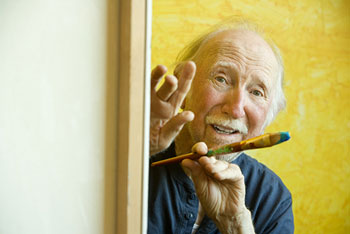Scientists are discovering that many long term memories are stored as images and aren’t destroyed by dementia or Alzheimer’s.
Doctors have noted that the big bad four A’s of Alzheimer’s is:
- anxiety;
- aggression;
- agitation; and
- apathy.
These characteristics often go away when they see or experience creative art. Their so-called “emotional memories” awaken and they seem to relate better to people and their surroundings.
Art therapist, Ruth Abraham is author of the book, When Words Have Lost Their Meaning: Alzheimer’s Patients Communicate Through Art (Praeger Publishers, 2004). She is a big proponent of using art therapy, saying that:
“it has been shown to be a powerful tool for people living with Alzheimer’s; it helps them to express their feelings when they can no longer do so with words. This use of art helps people with Alzheimer’s disease feel less lonely and isolated. It can also calm their restlessness.”

6 Tips for applying art therapy in a dementia care program
Here are 6 tips from the Alzheimer’s Association. (These ideas are for someone with middle to late stage Alzheimer’s)
1. Construct the project at an adult level, this will keep people interested and engaged.
2. Allow communication and conversation during the art activity. It provides a healthy and positive means for expression and gives staff the chance to encourage and praise the person creating the art.
3. Ask about the art being created and try to understand what it means to that person.
4. Assist the person with dementia to begin the activity, perhaps by doing the first brushstrokes or the first application of pastels. Don’t rush the session because this can lead to agitation and undermine the whole idea of art therapy.
5. Try scrapbooking as a fun and relatively easy activity. Provide colourful cut-outs from magazines and add some photographs from that person’s life – family members can be a big help for this kind of project.
6. Use safe, non-toxic glues and don’t provide sharp tools such as scissors.
Art for people living with dementia and their carers
This exhibition is part of the NSW Gallery’s program and they hold a regular art and dementia tour on the third Thursday of the month.
If you would like to engage us to take your Loved One to the Art Gallery, please give us a ring so we can arrange a Caregiver and / or transport for you or your Loved One: 9970 7333.



I have found Art Therapy to be a fantastic tool for dementia clients and those who have been artists in the past but have not done it for a while and need some guidance. It is a very effective form of expression and particularly enjoy sharing the sense of satisfaction and accomplishment they feel producing their artwork.
That’s good to hear Jackie and thanks for your comment. It’s great to hear of your own personal experience.
I have seen some amazing responses with wonderful tools such as Art & Poetry.
Artistic expression uses our emotions so I am not surprised when you mention Poetry in addition to art as people living with dementia are in touch with their emotional side of their being Thanks for sharing Lucille.
This is a positive way for someone with Alzheimer’s to communicate their feelings, their thoughts and memories. I read somewhere that we need to enter the world of the person with dementia rather than trying to make them enter into ours. A beautiful concept of using colour and strokes of a paint brush to help calm the person and hopefully bring pleasure and a sense of peace. I love this idea and will definitely include this activity with any client who needs a care plan that will bring a sense of calm into a chaotic mind.
Hello Patricia, I’m glad it appeals to you. We can all benefit from some creative self expression so I’m glad you can see a use for art with your clients. Thanks for your comment.
Introducing art is positive even at times when there is no interest,
I may start drawing a simple picture or have a colouring in book and with coloured pencils at hand, this simple session can initiate conversation